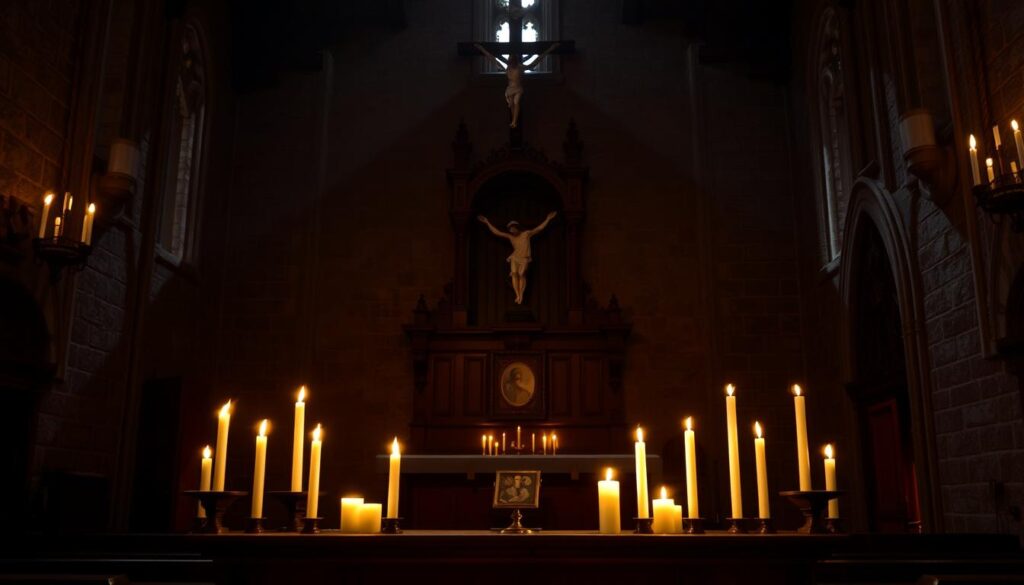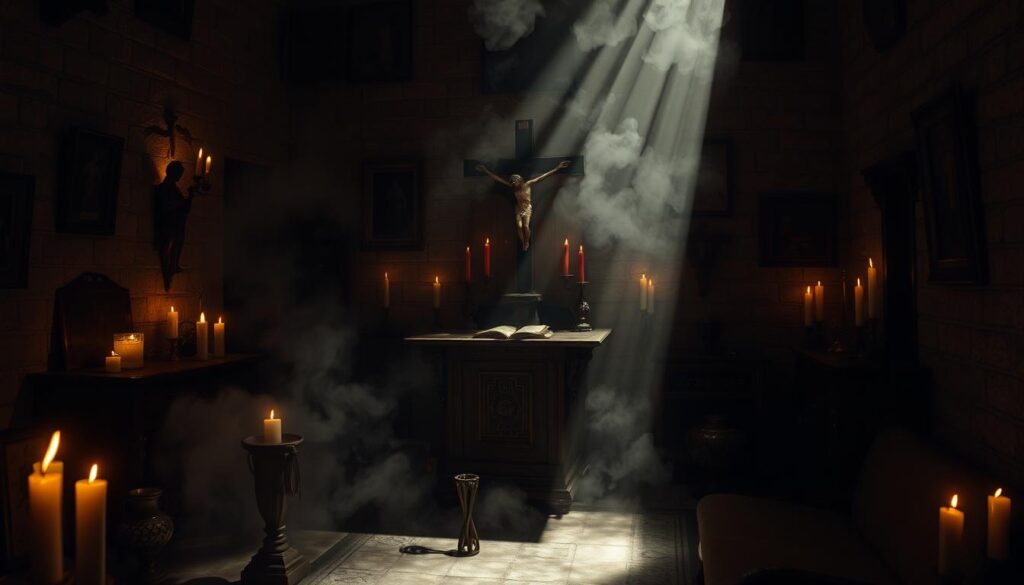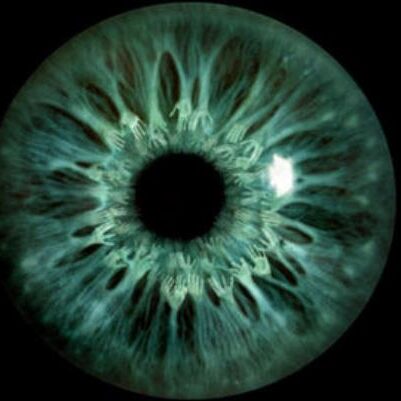Exorcism is a religious practice to remove evil spirits from people or places. It’s an old tradition in many cultures and religions. Famous cases have always fascinated people, from Jesus’ miracles to “The Exorcist” movie.
Key Takeaways
- Exorcism is an ancient religious and spiritual practice of evicting demons and malevolent entities from a person or place believed to be possessed.
- Numerous famous exorcism cases throughout history have captured the public’s attention, including the biblical accounts of Jesus and the events that inspired “The Exorcist” novel and film.
- Exorcism practices vary across different cultures and religions, with a rich history and tradition in many belief systems.
- The demand for exorcisms has been reported to have increased in recent years, with the Catholic Church and other Christian denominations responding to this trend.
- Exorcism cases often involve complex and sometimes controversial topics, including the nature of evil, the supernatural, and the limits of science and psychiatry in explaining certain phenomena.
Introduction to Exorcism
Definition and History of Exorcism
Exorcism is a religious or spiritual act to remove evil spirits from a person or place. It’s done by using rituals, commands, or oaths. This practice has been around for centuries, found in many cultures and religions.
By the third century A.D., exorcism was common. People believed left-handedness and certain phrases were signs of the Devil. During the Protestant Reformation, Martin Luther ordered exorcisms to be done often. This showed how important it was back then.
In recent years, exorcism has become more popular again. This is thanks to William Peter Blatty’s “The Exorcist” and its 1973 film. Exorcism is arguably more popular today than at any point in history, with the exception of sixteenth- and seventeenth-century Europe.
“The prevalence of exorcism in a culture can be linked more to levels of religious, social, and political upheaval rather than scientific understanding.”
Exorcism is a complex topic, showing the wide range of spiritual beliefs and traditions. Knowing about exorcism helps us understand its lasting impact on human spirituality and religion.
Exorcism in Christianity
In Christianity, exorcism is about removing demons from people thought to be possessed. Those who do this are called Christian exorcists. They use God, Jesus, angels, or archangels to help free the person from demons.
The idea of demonic possession and exorcism is old in Christianity. The Catholic Encyclopedia talks about King Saul in the Old Testament. The New Testament shows Jesus and his followers casting out evil spirits. This tradition has lasted through history.
Today, how exorcism is done varies among Christians. The Catholic Church has a strict process for exorcisms. The Anglican Church in England has a “deliverance ministry.” Lutherans and Baptists believe in demons based on the Bible.
| Denomination | Exorcism Practices |
|---|---|
| Catholic Church | Formal process for major and minor exorcisms, requiring bishop’s approval and specialist team |
| Anglican Church (Church of England) | Established “deliverance ministry” with teams trained in exorcism and psychiatry |
| Lutheran Church | Belief in the power of demons based on Scripture, with the name and power of Jesus used in exorcism |
| Baptist Churches | Belief in the existence and power of demons based on the New Testament |
Exorcism was rare in Western countries until the 20th century. The movie “The Exorcist” in 1973 and famous cases like Anneliese Michel in 1976 made it more known. These events sparked a new interest in Christian exorcism.

“Exorcism is the spiritual and religious practice of evicting demons or other spiritual entities from a person or place which the person believes is possessed.”
Exorcism in Catholicism
In the Catholic Church, exorcisms are done in Jesus Christ’s name to fight evil spirits. There’s a big difference between major and minor exorcisms. Minor ones are part of many blessings, like the blessing of salt. They’re also in the Rite of Christian Initiation of Adults.
Major exorcisms, however, are bigger rituals. They can only be done by a priest with the bishop’s okay. Beforehand, the person must get a medical check to make sure they’re not sick.
Major and Minor Exorcisms
The Catholic Church updated the Exorcism Rite in January 1999. Now, the old Rite in Latin is an option again. Solemn exorcisms, or major ones, need a priest and the bishop’s permission. The person must also pass a medical test to rule out mental illness.
The first rules for exorcism came in 1614. In the mid-1970s, in the U.S., more people claimed to be possessed. This was partly because of movies and TV shows.
Minor exorcisms, on the other hand, are part of many priestly blessings. They include the blessing of salt. These rituals help clean people of bad influences and strengthen their faith and community ties.
“The Vatican issued guidelines in 1999 stating that individuals claiming possession must first be evaluated by doctors to rule out mental or physical illness.”
The Catholic Church’s view on exorcism has changed over time. Now, they make sure people seeking help are properly checked. They also train priests to handle these situations correctly.
The 1949 St. Louis Exorcism
The 1949 St. Louis exorcism is a famous case of demonic possession. It started in January 1949 with a 13-year-old boy in Maryland. He had strange episodes like scratching sounds and moving objects.
His family tried many things but nothing worked. They then turned to the Catholic Church for help.
Jesuit priests, including Father William Bowdern, performed the exorcism. It took place over weeks at different places. These included a relative’s home and Alexian Brothers Hospital.
People heard the boy speak Latin in a strange voice during the ritual. The priest got hurt badly, needing 100 stitches.
This exorcism is well-known in St. Louis. It has influenced books and movies, like the 1973 film The Exorcist. This film won two Oscars and was a huge success.
But, some scholars doubt the true story of the 1949 exorcism. They point out contradictions and lack of solid evidence. In 2013, Saint Louis University discussed the case with experts.
John Waide, a university archivist, talked about how the media made the story bigger. Despite doubts, the 1949 St. Louis exorcism is still a big topic in the Catholic Church.
Eastern Orthodox Exorcism Tradition
The Eastern Orthodox Church has a deep tradition of exorcism. It goes back to Jesus’ time when he cast out demons. Orthodox Christians see demonic possession as a way the devil tries to control people and rebel against God. They believe objects can also be possessed.
Unlike the Roman Catholic Church, all Orthodox priests can perform exorcisms. They use prayers to cast out demons, calling on God through Jesus Christ. The Orthodox Book of Prayers has prayers by Saints Basil and John Chrysostom for those possessed by demons.
“Every priest is considered an exorcist, but not all may function well in the role, requiring a more specialized approach to exorcism.”
The Church knows about demonic possession and fights it with exorcisms. They also deal with the evil eye, known as vaskania. They say prayer and exorcism are the answers, not magic.
The Orthodox belief is that the devil’s power will end with the resurrection of the dead. But, there are worries about priests ignoring medical issues for spiritual reasons. There’s a call for better training and guidance in exorcism.

| Key Aspects of Eastern Orthodox Exorcism | Details |
|---|---|
| Biblical Origins | Rooted in biblical accounts of Jesus and the Apostles expelling demons |
| Clergy Involvement | All Orthodox priests are trained and equipped to perform exorcisms |
| Exorcism Prayers | Prayers of exorcism by Saints Basil and John Chrysostom are used |
| Belief in Demonic Possession | The Church recognizes the possibility of demonic possession and affliction |
| Approach to Exorcism | Invoking God through the name of Jesus Christ to expel demons |
Exorcism in Other Christian Denominations
Exorcism is not just for the Catholic Church. It’s also practiced in other Christian groups. The Lutheran Church and the Church of Jesus Christ of Latter-day Saints believe in it too. They see demonic possession as a real issue that needs divine help.
Lutheran and Mormon Practices
In Lutheranism, exorcism has been part of their tradition since the 16th century. They look for signs like knowing secrets, speaking unknown languages, and having superhuman strength. Before a big exorcism, Lutheran priests check if it’s not a medical issue first.
The ritual involves prayers and saying the Apostles’ Creed and the Lord’s Prayer. It’s about driving out demons with faith.
The Mormon Church also practices exorcism, but it’s rare. It’s done by those with the Melchizedek priesthood. They use oil, lay hands on the person, and command the spirit to leave in Jesus’ name.
“Exorcism remains a common practice in Christianity, with the Catholic Church actively performing exorcisms on possessed individuals.”
Exorcism in other Christian groups shows their belief in the supernatural. It shows how Protestantism and Christian denominations use religious rituals to fight evil.

Famous exorcism cases throughout history
For ages, stories of famous exorcism cases have grabbed our attention. From Jesus casting out demons in the Bible to the 1949 St. Louis exorcism that inspired “The Exorcist,” these battles against evil have always intrigued us.
In 1949, a 13-year-old boy in St. Louis went through a famous exorcism. It happened at his relatives’ house, Alexian Brothers Hospital, and St. Francis Xavier College Church. The ritual lasted over a month, with Father Bowdern fasting and praying every evening.
Many priests, Alexian Brothers, and family members were involved. The boy had to become Catholic as part of the ritual. Though the details were kept secret, the story is now a legend at St. Louis University.
Another famous case is Anneliese Michel’s exorcism in Germany in the 1970s. She went through 67 exorcisms over 10 months, facing severe mental and physical pain. Sadly, she died at 23 from dehydration and malnutrition after the rituals.
| Year | Exorcism Case | Location | Outcome |
|---|---|---|---|
| 1949 | St. Louis Exorcism | St. Louis, Missouri | Lengthy exorcism process, details never publicly disclosed |
| 1976 | Anneliese Michel Exorcism | Germany | 67 exorcisms over 10 months, resulted in Anneliese’s death at age 23 |
| 2005 | Exorcism of Maricica Irina Cornici | Romania | Maricica Irina Cornici died in an ambulance following the exorcism ritual |
These stories and others like them still captivate us. They show our deep interest in supernatural phenomena and the fight against demonic possession.

“Exorcism has been a part of virtually every religion throughout recorded history.”
Exorcism in Buddhism
Buddhism has its own way of dealing with evil forces, even though it’s not as well-known as in some Christian traditions. The Paritta is a key part of Buddhism. It involves chanting verses and suttas to keep evil spirits away.
The Āṭānāṭiya Sutta is a crucial text for this purpose. It talks about a ritual to protect followers from evil. This text guides Buddhists in how to keep negative forces at bay and stay spiritually strong.
Buddhism doesn’t focus on forcing evil spirits out. Instead, it emphasizes building a positive spiritual environment. This is done through chanting, meditation, and following Buddhist teachings. Even though it’s not as intense as some Christian rituals, Buddhist practices are vital in fighting evil.
“The Āṭānāṭiya Sutta, in particular, is a Buddhist text that describes a ritual intended to protect the faithful from demonic entities.”
Exorcism in Popular Culture
Exorcism has always caught people’s attention in popular culture. Many films, books, and media have explored this topic. The most famous is probably “The Exorcist,” a 1971 novel by William Peter Blatty.
This novel was made into a hit 1973 film by William Friedkin. It tells the story of a young girl possessed by a demon and the priests trying to save her. It drew in many viewers and made people think more about exorcism.
Films, Books, and Media
Other examples include the “Rite” film series and the “Paranormal Activity” franchise. These stories mix horror with the idea of demonic possession. Books like “Hostage to the Devil” by Malachi Martin also dive into exorcism’s history and theology.
These works, along with many other films, TV shows, and documentaries, have made exorcism well-known. They mix horror, spirituality, and the supernatural to grab people’s attention.
People’s interest in exorcism shows a big part of the population believes in demons and the supernatural. Over half of Americans think demonic possession is real. Most also believe in angels and demons.
This belief has led to a lot of media about exorcism. It keeps people curious and sparks their imagination.
FAQ
What is exorcism?
Exorcism is the act of removing evil spirits from a person or place. It’s an ancient practice found in many cultures and religions.
How is exorcism practiced in Christianity?
In Christianity, exorcism involves removing demons. An exorcist, often a priest, uses prayers and religious symbols to cast out demons. They call on God, Jesus, and angels for help.
What are the differences between major and minor exorcisms in Catholicism?
Catholicism divides exorcisms into major and minor types. Minor exorcisms are part of blessings and rituals. Deliverance ministry is another practice, focusing on healing emotional wounds.
Can you tell me more about the famous 1949 St. Louis exorcism case?
The 1949 St. Louis exorcism is well-known. It started with a 13-year-old boy experiencing strange episodes. Jesuit priests, including Father William Bowdern, performed the exorcism over several weeks. The details were kept secret until later.
How does the Eastern Orthodox Church approach exorcism?
The Eastern Orthodox Church views exorcism as a way to fight evil. They believe demons can possess objects and people. Orthodox exorcists use prayers to cast out demons, especially during baptisms.
How do other Christian denominations, such as Lutherans and Mormons, practice exorcism?
Lutherans and Mormons also practice exorcism. Lutherans check for medical reasons before exorcisms. Mormons use anointing and prayer to cast out spirits. Both focus on driving out demons with faith.
Are there any other famous exorcism cases throughout history?
Yes, many famous exorcism cases exist. The 1949 St. Louis exorcism inspired “The Exorcist.” Other cases include Anneliese Michel in Germany and Romanian nun Maricica Irina Cornici. These stories show our ongoing interest in the supernatural.
How is exorcism practiced in Buddhism?
Buddhism uses chanting to ward off evil. The Āṭānāṭiya Sutta describes a ritual to protect against demons. While not as well-known for exorcism, Buddhism has its own ways to deal with evil spirits.
How has exorcism been portrayed in popular culture?
Exorcism has fascinated many in popular culture. “The Exorcist” is a classic example. Other films and books, like “Rite” and “Paranormal Activity,” explore the topic. These works mix horror and spirituality, captivating audiences.
Source Links
- Exorcism of Roland Doe – https://en.wikipedia.org/wiki/Exorcism_of_Roland_Doe
- Exorcisms: The Centuries‑Long History of Expelling Evil | HISTORY – https://www.history.com/news/exorcisms-christianity-gospels-movie
- A Brief History of Exorcism – https://www.newyorker.com/humor/daily-shouts/a-brief-history-of-exorcism
- Exorcisms: A Brief History of Banishing Demons – https://crimereads.com/exorcisms-a-brief-history-of-banishing-demons/
- Exorcism in Christianity – https://en.wikipedia.org/wiki/Exorcism_in_Christianity
- The Catholic Church’s views on exorcism have changed – a religious studies scholar explains why – https://news.txst.edu/the-conversation/2022/catholic-churchs-view-on-exorcism-have-changed.html
- Exorcism in the Catholic Church – https://en.wikipedia.org/wiki/Exorcism_in_the_Catholic_Church
- Catholic exorcisms are real—and they have an ancient history – https://www.nationalgeographic.com/history/article/ancient-origins-of-catholic-exorcism
- SLU Legends and Lore: The 1949 St. Louis Exorcism – https://www.slu.edu/news/2019/october/slu-legends-lore-exorcism.php
- 1949 St. Louis Exorcism — Arch City Religion – https://www.archcityreligion.org/exorcism
- Answering the Cry: Exorcism in the Orthodox Church – https://scholarblogs.emory.edu/candlerdmin/2024/04/12/exorcism-orthodox-church/
- Exorcism in the Orthodox Church – Greek Orthodox Archdiocese of America – Orthodox Church – https://www.goarch.org/-/exorcism-in-the-orthodox-church
- Exorcism – https://en.wikipedia.org/wiki/Exorcism
- Exorcisms have been part of Christianity for centuries – https://theconversation.com/exorcisms-have-been-part-of-christianity-for-centuries-107932
- CATHOLIC ENCYCLOPEDIA: Exorcism – https://www.newadvent.org/cathen/05709a.htm
- Exorcism Exposé – https://www.slu.edu/universitas/archive/2014/exorcism.php
- 9 Real-Life Exorcisms — And The Terrifying Stories Behind Them – https://allthatsinteresting.com/real-exorcisms
- Are Exorcisms Real? 12 True Exorcism Stories – https://www.rd.com/list/real-life-exorcisms/
- A Thai Spirit Exorcism – https://www.spurlock.illinois.edu/blog/p/a-thai-spirit/105
- Possession, Exorcism, and History – https://academic.oup.com/book/3259/chapter/144249951
- 7 Bone-Chilling Stories of Real-Life Exorcisms – Rebel Circus – https://therebelcircus.com/culture/real-life-exorcisms/
- Why Are Exorcisms as Popular as Ever? – https://newrepublic.com/article/126607/exorcisms-popular-ever
- 10 Weirdest Exorcism Stories – Listverse – https://listverse.com/2018/10/25/10-weirdest-exorcism-stories/

